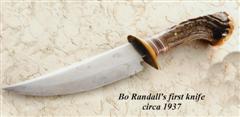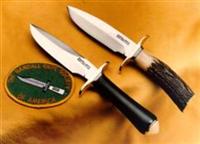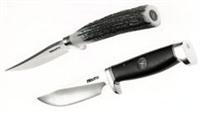
Knife Enthusiast
Registered: 11/16/05
Posts: 2855
|
Quote:
Well, now that you asked, this is what I think; by 1956 at the latest, ‘Bo’ Randall’s local sheath maker Clarence Moore, his ‘go to guy’ for low volume custom, first article, and prototype sheaths was out of the picture. Seeking a local maker for these types of special projects, it’s likely that ‘Bo’ gave a fair number of area based sheath makers a chance to prove themselves...
Purely supposition. No one really knows how many leather or harness shops were given a shot at sheath making if any were even interested at all. Not likely Stockman was involved any earlier than the late 50's as plenty of Heiser sheaths were on hand.
Quote:
In part due to a need for easy access, quality issues, price point per sheath, ability to deliver sheaths on short notice, or some combination of the above probably weeded out most of these sheath makers. But, the need for a local sheath maker hadn’t gone away...
The H.H. Heiser company, located far away in Colorado was having its own problems, the ownership of the company having exchanged hands several times in the years leading up to 1960. This situation may or may not have complicated deliveries of standard sheath models, but most certainly impacted their ability to deliver on any of the special project requirements in a timely fashion...
The initial driving force to find a local maker was for one offs so you could get a sheath in a reasonable amount of time. Otherwise, you have to send a knife to Colorado or make the sheath off possibly a cardboard pattern. Neither a desireable choice would be my guess.
Quote:
So, by 1959 RMK’s needs may have left them in a position whereby they were forced to take whatever they could get with regards to locally produced sheaths. Luckily, this was a slow period of sales, and they probably had a fairly large number of sheaths in stock...
Thus, based on slow sales, and fair number of sheaths on hand, Jim Stockman, and others, could have taken up much of the slack – with mixed results. Personally, I would believe that by 1961 Stockman’s sheath quality would have improved quite a bit. But, by 1961 business was picking up, orders from Heiser had probably slowed, and the need for a local sheath maker had become critical...
I am firmly convinced that the majority of Jim Stockman’s regular production sheaths – those patterned directly from separated Heiser sheaths, were produced in 1961. Further, that the number was fairly small, probably 300 to 400 in total, and that the quality was somewhat less finished than the original Heiser sheaths they were patterned after...
Since we know Stockman made a few sheaths at least as early as 1959, it is possible he was making sheaths into 1961. I don't know that he made the majority in that one year, I personally don't think that is the case. I think it was a somewhat steady thing where he supplemented the Heiser production on a VERY limited basis.
Bob Stockman in your conversations with him even told you that, that Randall would randomly get a few sheaths made over the few years of their involvement. He said an average of 5-6 a month was reasonable. Using your math, if they made half of what you say the total production was in your last year of 1961, say 200 sheaths, that would mean Stockman made a minimum of 17 sheaths/month over a full year. 34 a month if for only the first 6 mmonths. You don't think Bob Stockman would have remembered a big push at the end of their involvmeent? It just doesn't add up no matter how you slice it Sheldon.
Quote:
Usually defined by the use of reddish colored, thinner harness leather with a smoother look, these sheaths differed from Heiser versions by virtue of cut, finish, stitching, and overall appearance; Stockman standard RMK production sheaths, sheaths such as the one referenced in the original post, are similar, yet very different from those that they were patterned from...
Damn Sheldon, your description now has an uncanny resemblance to my description!!
The sheath you cite in the original post doesn't have any of those qualities you mention. It is a Johnson through and through. It and the one in your book look nothing like the two Stockman sheaths photos posted in this thread. You have yet to address these two sheaths and their obvious differences from any other regularly seen sheth from the period.
Quote:
This is where Maurice Johnson came into the picture; I believe that based on the sheer number of Johnson ‘Brown Button’ sheaths known to exist (and countless unknown), and the known introduction of the replacement nickel plated baby-dot snaps in late 1963, that it stands to reason that Maurice Johnson started making sheaths for RMK in 1961...this is what I wrote in our book...
Well, you wrote it wrong in your book. According to Gaddis page 225 in referncing the Baby Dot snap, "Since late 1962 or early 1963, all Johnson sheaths used these snaps....."
Looks like you are a year off on that one.
Quote:
On a side note – I also think the last sheath deliveries from Heiser were unmarked, and that the RMK sheath stamp was used on the last deliveries of both Heiser and higher quality Stockman sheaths. In addition, that these sheaths were stamped at the Randall Shop; that the stamp use preceded Johnson’s association with RMK; and that Johnson initially stamped his sheaths perpendicularly, as had the Randall Shop...
On a side note, no sheaths have ever been stamped in the Randall Shop. According to Pete Hamilton, they didn't even have a stamp. That hold true from some shop workers there prior to Pete. It holds true to this day, they don't stamp sheaths at the Randall Shop.
Quote:
Thus, during 1961, and maybe for a few months leading up to and after, unmarked and horizontally stamped sheaths for standard RMK production could have conceivably been made by at least three different sheath making sources.
No Stockman sheaths sport the Randall sheath stamp, none that I have seen. I don't believe Bo would have wanted his name on those inferior sheaths. If you don't know what the hell you are looking at or talking about and think a Johnson is a Stockman, then you may see many "Stockman" sheaths with the RMK stamp.
Quote:
That’s my thoughts on the matter; as always, your mileage may vary... 
|















